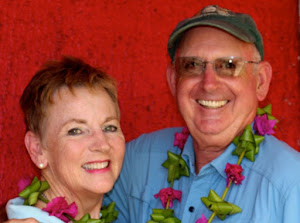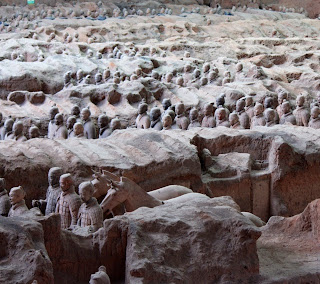 |
| In Front of Magao Grottoes |
Day 9 - Dunhuang
We assembled as a group around 9:30 and headed out to the very famous World Heritage site of the Mogao Grottoes, built between 200 BCE to 13-14th century CE by Buddhist believers who either dug for themselves or if they were wealthy enough hired artisans to build for them grottos dug out of the sandstone cliffs.
The grottos number about 700. Not all, but many are elaborately painted with mineral colors still quite vivid today. In one of the grottos there was a large reclining Buddha and in another there was a 35 meter high Buddha, third largest in China.
Story murals, Buddha statutes and shrines fill the grottos. Many of the grottos were stripped of statues, murals and artifacts by western explorers in the early 1900's and are in British, French, and American Museums. Today the site is beautifully preserved with wooden walkways, iron doors in front of each of the artistic grottos, to prevent, light, sand, and human raiders.
We returned to the hotel after a lunch that included donkey meat.
We gave it a try. Not bad. HawHee! During our time at the grottos, the wind kicked up and we experienced both a wind storm and rain showers. We could see black clouds hanging on the mountains. The rain is considered good luck. There is usually little or no rain here.
We purchased some playing cards representative of the Mogao Grottos art, and inquired of our guide Helen if she would teach us a Chinese card game. Yes she could, and yes she did. While we waited in the lobby for our transfer to the train station, Helen taught us how to play a three person game called Landlord. One of the players is the landlord and goes first trying to capture as many cards as possible and go out first. Its a fun little game but a bit different in terms of card ranks. Red Joker is highest card, black joker is next followed in descending order 5, 3, 2, Ace, King, Queen, Joker, 10, 9, 8, 7, 6, 4. We now have a remembrance of Dunhuang, China when we play this game.
The group boarded the bus at 6:30 for a 130 km, 3 hour drive from Dunhuang to a shabby station in the midst of a shabby coal mine town, LiuYuan. As we drove, the scenery changed from the lovely oasis of Dunhuang to scrub desert to dune desert with wind farms. The rain in the mountains was playing havoc with the already bumpy road as water flash flooded down from the mountains across dry washes in the road. Fortunately, the water was receding from earlier in the day and we crossed all the washes safely. Some trucks that had been in the wrong place earlier in the day when the flooding was at its peak were buried in mud and sand up to their axels.
As the sun sank in the sky, the desert changed from sand to small mountains of tailings and coal. A volcanic moonscape stretched for miles in every direction. Old industrial buildings and soulless apartment buildings became more pronounced as we neared LiuYuan. This place looked like the coal mining province in the Hunger Games.
I found it quite depressing. Our train was to arrive at 10:30. It was now 9:30. We had an hour wait, but then we got word that the train, also because of the flash flooding, was delayed until midnight. Ugh! We were tired and sitting around in a packed, smelly station was not welcome. The train station did have a boiling water dispenser, so Russ and I fixed ourselves hot soup from our soup stash and called it dinner.
Our train finally arrived to take us to TuLuFan, a town 50 minutes or so from Turpan. It was almost 1:00 a.m. in the morning and the car, and berth room to which 3 of our group had tickets, already had one sleeping passenger. Quietly, we stowed our stuff in the dark, and fell on to our beds. Until last night when we slept on a box spring (traditional hard Chinese mattress), we thought the berths were not terribly comfortable. i guess everything is relative, because it felt pretty soft as we drifted to sleep only to get up and off the train by 7:15.
Day 10 - Turpan - Along the Silk Road
The scenery this morning as we awoke were mountains in the distance and oil wells in the desert. Russ and I ate some of our granola bars for our breakfast. We were met at the train station, by our new guide Serena. Getting off the train was easy as the platform was high and it was a small little ramp down, but it was a middle track which required us to go down two flights of steps, under a subway walk, and backup two flghts of steps carrying all of our gear, then up a cobbled street to the van, huff puff!Turpan is another Oasis city, and is where the Silk Road forks north or continues west to Kashgar. This city has about 200,000 people who live in one of the hottest, lowest deserts in the world. But there is water here so it is habitable. The province is autonomous from the rest of China, but not really. It has relaxed restrictions due to its rural and remote environment. Because it is a farm community (sweetest grapes in the world), young people can marry here at 18, instead of 20 and can have 2-3 children to help with the farming.
Our van descended from the train station 155 meters almost 450 feet below sea level to reach Turpan. I could feel my ears popping as I acclimated during our descent.
The group was eager to check into our hotel rooms at the Turpan Hotel.
It is going to only be in the low100s today, but the air conditioning in our hotel seemed to be struggling. Since our group would not gather until 1:00 pm, we had the rest of the morning (3 hours) to do as we pleased. Russ and I did some laundry, took cold showers, and went out to lunch.
Today, we visited a mosque built in 1777, an ancient underground irrigations system which tapped snow melt coming down from the Celestial mountains (Xinjiang Karez),
 |
| Irrigation wells to underground river complex |
and visited the ancient city of Yar,
which was an extensive city made of mud (the first Turpan), 200 BC to first century BCE. It was hotter than heck!
I decked myself in a wet sarong over my head, looked like a hajib. At the finish of or day in the desert, we feasted on sweet watermelon.
Tomorrow, we leave for Kashgar.
All isWell with the Worrall Travel Rs.
































































